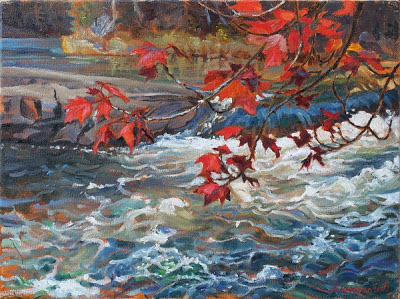Looking Down at Scotts' Pond (oil on canvas 5 x 7 in.) Sold
I'm fascinated with the reflection of the trunks of the bushes that overhang the water, and the aquatic moss that covers the submerged trunks like heavy shaggy sleeves. The bank itself, which would be shaded by the Manitoba Maple in summer, is littered with curled, dry leaves over bare clay. Down near the edge the Coltsfoot, which will leaf out later, is sending up single yellow blooms on velvety pale stems. As the afternoon aged, the flowers closed up to rest for the night.
Viewed from an unusual angle, this scene presents a challenge, especially as the sun peeked in and out among the clouds, the reflections changed and the bottom became more and less visible by turns.
Fred wrote:
This afternoon we took Marigold the Dog to see her boyfriend, at Scott's Lilliput Farm (they ran constantly and performed, using a raft and a boy, antics that would have gone viral on u-tube if we'd only had a video camera), and Aleta did her daily painting.
Just before we left home we heard a couple of calls from a Grey Treefrog, ushering in the late spring, with the stuttering quality one hears early in their season, presumably before the vocal cords have been stretched.
Then at Scotts, Aleta painted Tussalago (Coltsfoot), a memento of the early spring, in bloom on a north-facing bank of the clay spoil piles that were excavated when Scotts dug their irrigation pond in 1995. Now the piles are completely vegetated (mostly Phalaris arundinacea, Reed Canary Grass), and on these north-facing slopes it's Tussalago. The bank painted is under a spreading, surprisingly large Manitoba Maple, which has grown 2 trunks of about 23 cm diameter since germinating no earlier than 1995, 2 metres up on the steep slope of the spoil pile.
There's now no sign of the fossil Champlain Sea mini-clams, Hiatella and Macoma, that littered the clay when the pond was first excavated, and we didn't find any shells of land snails, either. The granular clay and the litter layer of Manitoba Maple leaves looked ideal for snails, but probably suitable colonists haven't arrived across the soggy surrounding open fields. The ground under the tree was sparsely colonized by seedlings of Red Osier Dogwood and Cathartic Buckthorn, so probably the next stage in the vegetation of the site will be a struggle between the alien Rhamnus and the native Cornus.
The water was dimpled by the movements of little fish, probably Chrosomus dace, and Sticklebacks, but we didn't see any frogs all afternoon. In most years Leopard Frogs hibernate here in large numbers, but this year they must have gotten away to the breeding marshes before Phillip Scott and I circumperambuted the pond on the 3rd of April, seeing only 1 Leopard Frog, 1 Green Frog, and 1 Wood Frog. We did see a large numbers of shells of Helisoma campanulatum (Bellmouth Ramshorn Snail), which seem to have colonized the pond in the past few years.
Intermittent Peeper choruses wafted in from various directions, with the winnowing of Snipe and calling flocks of Geese, until at dusk, as Aleta finished the painting, the Peeper choruses became continuous, and were joined by a few Toads and the peenting of Woodcock, one of them very close to the Scotts house.




This was a hard composition, since the viewer comes to it with the experience that trees are usually vertical and the ground is pretty much horizontal, whereas in this case the trees were spreading out horizontally from the base of the vertical bank due to the shade of the (unseen) overhanging Manitoba Maple. This means that the blue behind the trees is the horizontal surface of the water, but that's made ambiguous by the puffy masses of Moss on the bases of the trunks, under the water, and the fact that there's no simple system of reflections to provide satisfactory clues about orientation and angles.
ReplyDeleteIf you look at it for a while (by putting it on your desktop, for instance) you see all the parts come together into the scene.